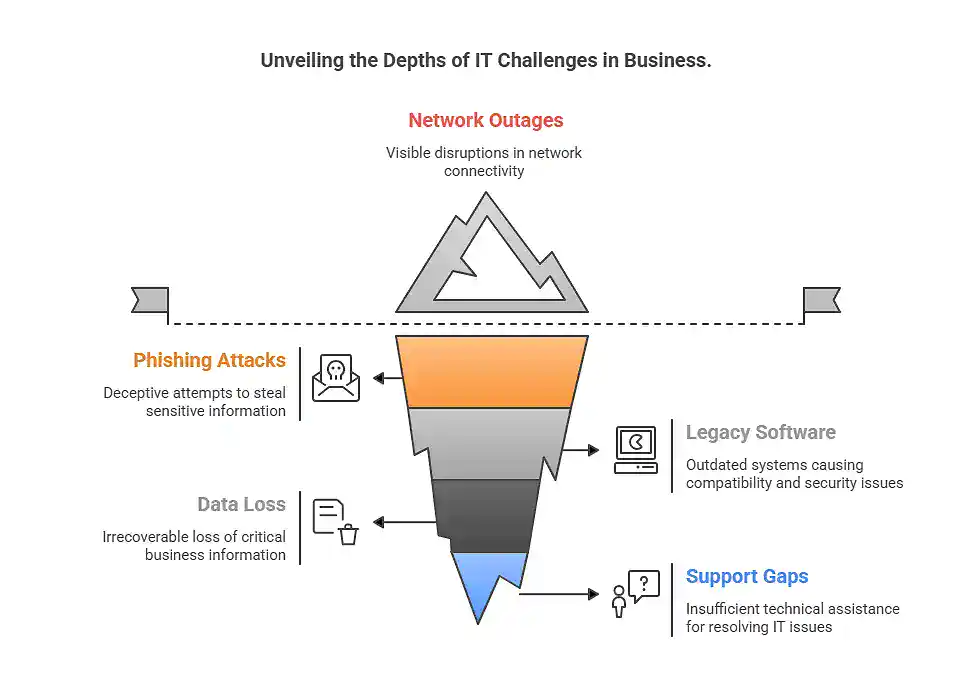When systems stall, the ripple effect reaches far beyond the IT department. Roughly 49% of employees report losing one to five hours of productivity each week due to IT problems. These disruptions not only slow down workflows; they quietly drain resources and stall momentum.
The real impact? Drop in productivity = Lost revenue.
| Paul Marchese, CEO of MCP, puts it clearly: “IT problems are rarely just about malfunctioning hardware or glitchy software; they often signal deeper inefficiencies that quietly drain resources and drag down productivity.” |
IT problems are not random events. They are consistent signals of systemic issues that drain time, money, and focus.
This blog breaks down the underlying causes, how these problems escalate across your business, and the strategies you need to resolve them with confidence.
What Causes the Most Persistent Technology Problems in the Workplace
On the surface, a frozen laptop during a critical meeting seems like a mere inconvenience, but it’s more. It’s a symptom of deeper issues that quietly erode productivity and performance. These disruptions often feel random, but they’re rooted in patterns that you can identify and address.
Here are the most common drivers behind persistent technology problems:
- Outdated Hardware: Aging devices are one of the top causes of downtime. Legacy systems face 5 times as many unplanned outages. Slow performance and frequent failures lead to lost hours and rising repair costs.
- Software Conflicts: Incompatible platforms trigger unplanned outages for many businesses. When systems clash, productivity unravels fast.
- Security Lapses: Misconfigurations and missed updates drive a large portion of breach incidents. Implementing stronger controls and routine maintenance can prevent costly exposure.
- User Training Gaps: Human error facilitates 95% of breaches. Without ongoing education, even the best tools fall short.
- Fragmented Systems: Disconnected workflows and siloed platforms make coordination harder and increase the risk of failure.
Each of these issues chips away at efficiency until one incident brings everything into sharp focus, and not in a good way.
Here’s a quick breakdown of what issues matter most:
| Common Issue | Likely Root Cause | Business Risk | Effective Fix |
| Slow Wi-Fi | Overloaded access points | Reduced productivity | Upgrade hardware, optimize channels |
| Software Crashes | Incompatible updates | Data loss, user frustration | Standardize software, test patches |
| Poor Backup | Infrequent or failed jobs | Permanent data loss | Automate, verify backup routines |
| Unauthorized Access | Weak credentials | Security breach, compliance | Enforce MFA, conduct regular audits |
| Hardware Failures | Lack of preventive care | Unplanned downtime | Schedule maintenance, refresh aging assets |
Stop IT Problems from Sabotaging Your Business Growth!Identify hidden tech weaknesses, prevent downtime, and reclaim hours of lost productivity. |
How IT Problems Disrupt Business and What Leaders Can Do
It’s 10:13 AM, and your sales team is in the middle of a demo when a server outage hits. Calls flood into IT, and every minute of silence feels like a missed opportunity. This isn’t a rare fluke; it’s a daily reality for many organizations.
The average company experiences 14 hours of IT downtime per year, and even brief disruptions can derail revenue, frustrate clients, and create internal confusion.
Here are the pressure points where IT problems hit hardest:
- Security Breaches: The average cost of a data breach sits at $4.44 million, with lasting damage to customer trust and regulatory standing.
- Downtime Costs: Unplanned outages cost enterprises an average of $9,000 per minute, halting operations and delaying critical projects.
- Revenue Loss: Even minor interruptions may reduce annual revenue, especially in mid-sized organizations.
- Compliance Risks: Penalties for non-compliance can reach $14.82 million per violation, plus the cost of remediation and increased oversight.
- Reputational Harm: A cyber incident caused 43% of companies to lose current customers, proving that reputational impact can exceed technical recovery.
What Leaders Can Do
In today’s hybrid workforce, the stakes are much higher. Remote access is essential, and even minor glitches can stall productivity. Businesses with responsive remote IT support minimize disruptions and protect performance. Every minute saved in diagnosis and resolution matters, especially when remote work is now a permanent fixture.
| Pro Tip
Organizations with secure, locally owned data centers often face fewer third-party risks and earn higher client trust. |
Here’s how leaders can tackle technology issues in business before they spiral out of control:
- Schedule Maintenance: Proactive updates and system checks prevent small glitches from becoming major disruptions.
- Use Real-Time & AI Monitoring: Early detection of anomalies with AI reduces incident response time by up to 70%, improving uptime and user experience.
- Train Continuously: Ongoing education keeps IT staff and end users equipped to handle evolving technology and reduce support tickets.
- Define Escalation Paths: Clear roles and responsibilities speed up resolution and eliminate accountability gaps.
- Streamline Vendor Management: A single point of contact simplifies procurement and support, while integrated onboarding and offboarding tighten security.
Persistent IT problems rarely disappear with a quick fix. High-performing organizations rely on structure, coordination, and process, not just tools. If your IT feels fragmented, a unified approach could be the key to resolving hidden inefficiencies.
Common IT Problems in Business: An Uncompromising Examination of Persistent Challenges
When leaders assess their IT landscape, the same pain points surface again. These aren’t abstract risks; they’re real-world threats that stall operations, erode trust, and demand fast, effective solutions.
Even with automation and advanced tools, these problems persist under the daily pressures of fast-paced business environments.
Here are the most persistent challenges that disrupt performance and demand immediate attention:
- Network Outages: 91% of businesses experience at least one outage quarterly. Even a brief disruption can freeze revenue, delay customer responses, and leave teams stranded.
- Phishing Attacks: Malicious emails disguised as legitimate requests exploit human behavior. A single click can trigger ransomware or expose sensitive data.
- Legacy Software: Unsupported platforms introduce vulnerabilities, complicate compliance, and slow innovation.
- Data Loss: Whether caused by deletion, hardware failure, or cyberattack, losing data impacts credibility, momentum, and legal standing.
- Support Gaps: Without accessible helpdesk support, even minor issues can escalate. Rapid triage via phone or email can stabilize operations.
These challenges demand more than reactive fixes. They require vigilance, structure, and a support framework strong enough to catch problems before they spiral. If your systems feel exposed, where could a more resilient approach make the difference?
| Read More: |
Discover How MCP Can Solve Your Business IT Problems
Recurring IT problems don’t disappear with quick fixes. Building true resilience means adopting a layered strategy, one that combines vigilant system monitoring, robust user training, and rapid incident response. Anything less allows risk to linger beneath the surface.
As the oldest technology and managed IT provider in Western New York, MCP brings more than four decades of insight to every engagement. That experience isn’t mere history; it’s a tactical advantage that helps identify and resolve disruptions before they escalate.
Here’s how MCP delivers client-centered support that drives results:
- Proven Track Record: Clients under MCP’s Managed Services have never experienced a security breach, reflecting uncompromising standards.
- Anticipatory Management: Deep experience enables MCP to solve problems before they surface.
- Seamless Support: From daily troubleshooting to strategic planning, MCP offers a single, responsive point of contact.
| Explore our range of IT Support services near you:
|
Connect with us today if you’re ready to transform your IT outcomes with a proactive partner. The next leap in performance starts with the right support.









